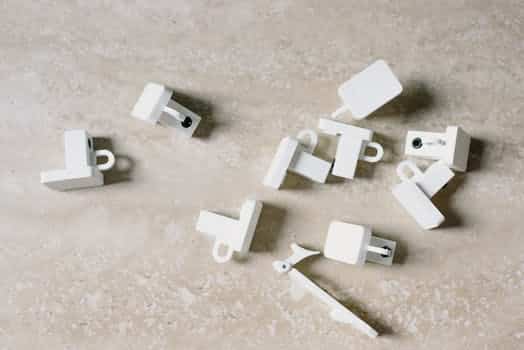Are you tired of your old and worn-out furniture? Looking for creative ways to give them a new lease of life? Look no further! In this article, we will explore 10 innovative and inspiring furniture refurbishing ideas that will transform your space. From upcycling to repurposing, these ideas will not only add a unique touch to your décor but also help you reduce waste and save money. Get ready to unleash your creativity and embark on a thrilling journey of furniture transformation!
- 1. Introduction
- 1.1. Understanding Furniture Refurbishing
- 1.2. Benefits of Refurbishing Furniture
- 1.3. Choosing the Right Furniture for Refurbishing
- 1.4. Essential Tools for Furniture Refurbishing
- 1.5. Safety Precautions
- 2. Preparation
- 2.1. Inspecting and Cleaning the Furniture
- 2.2. Removing Old Paint or Finish
- 2.3. Repairing Damaged Parts
- 2.4. Sanding the Surface
- 2.5. Filling and Smoothing Imperfections
- 3. Refinishing Techniques
1. Introduction
Refurbishing old furniture is a fantastic way to bring new life and character into your home. Whether you’re a creative DIY enthusiast or simply looking to give your space a unique touch, these 10 creative furniture refurbishing ideas will inspire you to transform your old pieces into stunning masterpieces. From repainting and reupholstering to adding decorative accents and repurposing, there are endless possibilities to explore. So, let’s dive into the world of furniture refurbishing and discover some exciting ideas to unleash your creativity!
1.1. Understanding Furniture Refurbishing
Furniture refurbishing is the process of restoring or renovating old, worn-out furniture to give it a fresh and updated look. It involves repairing any damages, refinishing surfaces, and sometimes even altering the design to enhance its appeal. This practice has gained popularity in recent years as more people are looking for sustainable and cost-effective ways to decorate their homes.
By refurbishing furniture, you not only breathe new life into old pieces but also contribute to reducing waste and preserving valuable resources. It allows you to give a personal touch to your home decor while saving money compared to buying brand new furniture.
In this article, we will explore ten creative furniture refurbishing ideas that can inspire you to transform your old furniture into unique and stylish pieces. Whether you’re a DIY enthusiast or someone looking to hire a professional, these ideas will help you revamp your living space with character and charm.
1.2. Benefits of Refurbishing Furniture
Refurbishing furniture is a highly rewarding and cost-effective way to give your old pieces a new lease on life. Whether you have inherited furniture from your grandparents or found a unique piece at a thrift store, refurbishing allows you to transform it into something fresh and stylish. Not only does it provide a creative outlet for your imagination, but it also offers several benefits.
Firstly, refurbishing furniture is an environmentally friendly choice. Instead of buying new furniture and contributing to the demand for more resources, refurbishing allows you to reuse and repurpose existing pieces. By breathing new life into old furniture, you can reduce waste and minimize your carbon footprint.
Secondly, refurbishing furniture gives you the opportunity to customize it according to your personal taste and style. Whether you prefer a vintage look or a more modern design, you can choose the colors, finishes, and patterns that suit your aesthetic preferences. This level of personalization is often not possible with new furniture, which tends to have limited options.
Additionally, refurbishing furniture can save you a considerable amount of money. Rather than investing in expensive new pieces, you can find affordable or even free furniture that may only need a little TLC. With some basic tools, materials, and a little bit of effort, you can transform these worn-out pieces into stunning focal points for your home.
Furthermore, refurbishing furniture can be a fulfilling and enjoyable hobby. It allows you to unleash your creativity and experiment with different techniques and styles. Whether you enjoy painting, staining, or upholstering, refurbishing furniture offers endless possibilities for expressing your artistic side.
In conclusion, refurbishing furniture is a fantastic way to breathe new life into old pieces while enjoying numerous benefits. It is an eco-friendly choice, allows for customization, saves money, and provides a creative outlet. So why not embark on a furniture refurbishing project and discover the joy of transforming something old into something beautiful?
1.3. Choosing the Right Furniture for Refurbishing
Choosing the right furniture for refurbishing is crucial when undertaking any creative furniture refurbishing project. Whether you are looking to update an old piece of furniture or breathe new life into a thrift store find, selecting the right furniture is the first step towards achieving a successful refurbishing outcome. This article will explore 10 creative furniture refurbishing ideas and provide helpful tips on how to choose the perfect furniture for your project. By considering factors such as the condition, style, and functionality of the furniture, you can ensure that your refurbishing efforts yield stunning results. Let’s dive into the exciting world of furniture refurbishing and discover the endless possibilities!
1.4. Essential Tools for Furniture Refurbishing
Refurbishing furniture can be a fun and rewarding DIY project. Whether you want to breathe new life into an old piece or repurpose furniture to fit your unique style, having the right tools is essential. In this section, we will explore some of the essential tools you will need for furniture refurbishing.
1.5. Safety Precautions
Furniture refurbishing is a creative and rewarding way to give new life to old pieces. However, it is important to prioritize safety when undertaking any DIY project. By taking certain precautions, you can ensure a safe and enjoyable experience. This section will outline some key safety measures to keep in mind while refurbishing furniture.
2. Preparation
Preparing for a furniture refurbishing project requires careful planning and consideration. Before diving into the creative process, it is important to gather all the necessary tools and materials. Here are some key steps to prepare for your next furniture refurbishing endeavor:
1. Assess the furniture: Start by examining the piece of furniture you plan to refurbish. Take note of any damages, scratches, or areas that need special attention. This will help you determine the extent of the refurbishing process.
2. Set a budget: Determine how much you are willing to spend on the refurbishing project. This will guide your decisions when it comes to purchasing paint, tools, and other necessary materials.
3. Research inspirational ideas: Look for inspiration and ideas that align with your vision for the furniture piece. Browse through magazines, websites, and social media platforms to gather unique and creative refurbishing ideas.
4. Gather materials: Make a list of all the materials and tools you will need for the project. This may include sandpaper, paint brushes, primer, paint, varnish, and any other supplies specific to the refurbishing technique you plan to use.
5. Prepare the workspace: Set up a designated area for your refurbishing project. Make sure the space is well-ventilated and protected with drop cloths or newspapers to avoid any accidental spills or damage.
6. Clean and prep the furniture: Before starting the refurbishing process, thoroughly clean the furniture piece to remove any dirt, dust, or grime. If necessary, use a mild cleaner and let the furniture dry completely.
By following these preparation steps, you will be well-equipped and ready to embark on your creative journey of furniture refurbishing.
2.1. Inspecting and Cleaning the Furniture
Inspecting and cleaning the furniture is an essential step in preparing it for refurbishing. Before diving into any creative ideas, it is crucial to ensure that the furniture is in good condition and free from dirt and damage. This section will guide you through the process of inspecting and cleaning your furniture before you begin the refurbishing process. By following these steps, you can ensure that your finished piece will not only look great but also last for years to come.
1. Inspect the furniture: Start by carefully examining the furniture for any structural issues, loose joints, or damaged parts. Look for cracks, chips, or any signs of wear and tear. This will help you identify the areas that need special attention during the refurbishing process.
2. Clean the surface: Use a mild detergent or furniture cleaner to remove dirt, dust, and grime from the surface of the furniture. Gently wipe the entire piece using a soft cloth or sponge. Pay close attention to intricate details and hard-to-reach areas.
3. Remove old finishes: If the furniture has an existing finish, such as paint or varnish, you may need to strip it off before proceeding with the refurbishing. Follow the instructions on the stripping product and use a scraper or sandpaper to remove the old finish.
4. Repair any damages: If you noticed any cracks, chips, or loose parts during the inspection, now is the time to repair them. Use wood filler or epoxy to fill in any gaps or cracks. Tighten loose joints or screws to ensure the furniture is sturdy and secure.
5. Sand the surface: After removing the old finish and making necessary repairs, sand the entire surface of the furniture using fine-grit sandpaper. This will help create a smooth and even surface for the new finish to adhere to.
By thoroughly inspecting and cleaning your furniture, you are setting the foundation for a successful refurbishing project. Taking the time to prepare your piece properly will ensure that the end result is a beautiful, functional, and long-lasting furniture item.
2.2. Removing Old Paint or Finish
Removing Old Paint or Finish
One of the first steps in refurbishing furniture is to remove the old paint or finish. This is important because it allows you to start with a clean slate and ensures that the new finish will adhere properly. There are several methods you can use to remove old paint or finish, depending on the type of furniture and the desired result.
One common method is to use a chemical paint stripper. This involves applying the stripper to the surface and letting it sit for a specified amount of time. The stripper will soften the old paint or finish, making it easier to scrape off. Be sure to follow the instructions on the stripper carefully and wear protective gloves and goggles.
Another option is to use sandpaper or a sanding machine. This method requires manual labor but can be effective in removing the old paint or finish layer by layer. Start with a coarse-grit sandpaper to remove the majority of the paint or finish, then switch to a finer-grit sandpaper for a smoother finish.
If you prefer a more natural approach, you can also try using heat to remove the old paint or finish. A heat gun or a hairdryer can be used to soften the paint or finish, making it easier to scrape off with a putty knife or a scraper. Take caution not to overheat the surface to avoid damaging the furniture.
Once the old paint or finish has been removed, make sure to clean the surface thoroughly to remove any residue or debris. This will ensure a smooth and even application of the new finish. With the old paint or finish removed, you are now ready to move on to the next step in refurbishing your furniture.
2.3. Repairing Damaged Parts
When it comes to refurbishing furniture, repairing damaged parts is often a necessary step. Before you can start with the creative process, it’s important to address any broken or worn-out components. This will ensure that the finished piece not only looks beautiful but also functions properly.
To begin the repair process, carefully assess the furniture for any cracks, chips, or missing parts. If there are loose joints or screws, tighten or replace them as needed. For small cracks or chips in wooden furniture, you can use wood filler or putty to fill in the imperfections. Sand the repaired area until it’s smooth and level with the surrounding surface.
In cases where a larger section of the furniture is damaged, such as a broken leg or armrest, you may need to consider more extensive repairs. Depending on the material, you might be able to glue or reinforce the broken piece. Alternatively, you might need to replace the entire section with a new one.
Remember to take your time and be patient during the repair process. Rushing through the repairs can result in subpar outcomes. Once the damaged parts are fixed, you can move on to the exciting part of refurbishing – the creative ideas that will transform your furniture into a unique and stunning piece that you’ll love.
2.4. Sanding the Surface
Before you start refurbishing your furniture, it is essential to properly prepare the surface by sanding it. Sanding helps to remove any existing finish, smooth out imperfections, and create a clean and even surface for painting or staining. Here are some steps to follow when sanding the surface:
1. Gather the necessary tools: You will need sandpaper or a sanding block, a sanding sponge, and possibly an electric sander for larger pieces of furniture.
2. Start with coarse-grit sandpaper: Begin by using a coarse-grit sandpaper to remove the existing finish or paint. Sand in the direction of the wood grain, applying even pressure. This will help to remove any bumps or rough areas on the surface.
3. Switch to finer-grit sandpaper: Once the majority of the old finish has been removed, switch to a finer-grit sandpaper to smooth out the surface further. This will help to create a sleek and polished look.
4. Use a sanding sponge for curved or intricate areas: For furniture with curved or intricate details, a sanding sponge can be more effective in reaching those hard-to-reach spots. The sponge conforms to the shape of the surface, allowing for more precise sanding.
5. Remove dust and debris: After sanding, use a soft cloth or vacuum cleaner to remove any dust or debris from the surface. This will ensure a clean surface for painting or staining.
By properly sanding the surface, you will be ready to move on to the next step of refurbishing your furniture and unleash your creativity in transforming its appearance.
2.5. Filling and Smoothing Imperfections
When refurbishing furniture, one of the essential steps is filling and smoothing any imperfections. Whether you are working with wooden furniture or upholstered pieces, this process will ensure a flawless end result. Start by inspecting the furniture for any cracks, dents, or scratches. For wooden furniture, use wood filler to fill in any holes or gaps. Apply the filler with a putty knife, making sure to smooth it out evenly. Once it dries, sand the filled areas with fine-grit sandpaper until they are level with the rest of the surface. For upholstered furniture, use a fabric patch or upholstery filler to repair any tears or holes. Apply the filler, smooth it out, and let it dry before sanding lightly. Sanding will help blend the filled areas with the surrounding fabric. By taking the time to fill and smooth imperfections, you will create a solid foundation for the rest of the refurbishing process.
3. Refinishing Techniques
Refinishing Techniques for article 10 Creative Furniture Refurbishing Ideas.
When it comes to refurbishing furniture, there are numerous techniques that can be used to bring new life to old pieces. Refinishing is a popular choice among DIY enthusiasts and professionals alike. Here are some creative refinishing techniques that can transform your furniture into unique and eye-catching pieces.
1. Paint
One of the easiest ways to give your furniture a fresh look is by painting it. You can choose from a wide range of colors and finishes to match your style and preferences. Before painting, make sure to clean the surface thoroughly and apply a primer for better adhesion. Consider using stencils or painter’s tape to create interesting patterns and designs.
2. Stain
Staining is another popular refinishing technique that can enhance the natural beauty of wood furniture. It allows you to highlight the grain and create a richer, deeper color. Before applying the stain, sand the surface to remove any existing finish and ensure smoothness. Apply the stain evenly with a brush or cloth, following the wood’s grain direction.
3. Distressing
Distressing is a technique that gives furniture an aged and worn look. It involves intentionally creating scratches, dents, and other signs of wear and tear. You can achieve this effect by using various tools like hammers, chains, and sandpaper. After distressing, consider applying a coat of paint or stain to add further character.
4. Decoupage
Decoupage is a technique that involves decorating furniture with cut-out images or patterns. It allows you to customize your furniture with a wide range of designs, from vintage newspapers to colorful magazine clippings. To achieve this look, apply a layer of adhesive to the furniture surface, place the cut-outs, and seal with several coats of varnish.
5. Upholstery
If you have old furniture with worn-out or outdated fabric, consider reupholstering it. Upholstery gives you the opportunity to choose new fabrics, patterns, and textures to suit your taste. You can either hire a professional or learn to do it yourself with some basic sewing skills and tools.
These are just a few refinishing techniques that you can try to revamp your furniture. Each method offers a unique way to breathe new life into old pieces and unleash your creativity. So, roll up your sleeves, gather your materials, and get ready to transform your furniture into stunning conversation starters.
3.1. Painting Furniture
Painting furniture is a great way to give old pieces a new lease on life. Whether you want to update a worn-out dresser or add a pop of color to a plain table, refinishing techniques can help transform your furniture into something beautiful and unique. Here are some creative ideas to inspire your furniture refurbishing project.
1. Chalk Paint: Chalk paint is popular for its matte, vintage look. It creates a soft, velvety finish and requires little to no prep work. Simply apply the paint to your furniture using a brush or roller, and distress the edges for a shabby chic effect.
2. Ombre Effect: The ombre effect involves blending two or more shades of paint to create a gradient effect. It works particularly well on pieces with multiple drawers or shelves. Start with a dark shade at the bottom and gradually lighten the color as you move upward.
3. Stenciling: Stenciling adds intricate patterns or designs to your furniture. Use stencils and acrylic paint to create a unique and personalized look. You can stencil the entire piece or focus on specific areas like drawer fronts or table tops.
4. Two-Tone Furniture: Give your furniture a modern twist by painting it in two contrasting colors. This technique works well on dressers, side tables, or chairs. Choose colors that complement each other and apply them to different sections of the furniture for a striking visual impact.
5. Distressed Finish: The distressed finish is perfect for achieving a vintage or farmhouse look. After painting your furniture, use sandpaper or a sanding block to gently distress certain areas, such as corners and edges. This will give your piece a weathered appearance.
6. Metallic Accents: Add a touch of glamour to your furniture by incorporating metallic accents. Choose a metallic paint in gold, silver, or bronze and apply it to details like drawer pulls, trim, or legs. This will instantly elevate the look of your piece.
7. Decoupage: Decoupage involves adhering paper or fabric to your furniture using a special glue or varnish. This technique allows you to create intricate designs or incorporate patterned materials onto your piece. It works well on tabletops, cabinet doors, or the backs of chairs.
8. Whitewashing: Whitewashing is a technique that creates a light, washed-out look. It involves diluting white paint with water and applying it in thin layers to your furniture. This technique is great for achieving a coastal or beachy vibe.
9. Faux Finish: Faux finish techniques, such as marbleizing or wood graining, can give your furniture the appearance of expensive materials. These techniques require some practice and skill but can result in stunning and realistic finishes.
10. Color Blocking: Color blocking involves painting different sections of your furniture in solid blocks of color. This technique works well on modern or minimalist pieces. Choose bold, contrasting colors to create a striking visual statement.
These refinishing techniques offer endless possibilities for transforming your furniture. Whether you prefer a rustic, vintage, or contemporary look, experimenting with different techniques can help you achieve the desired effect. So get your paintbrushes ready and start revitalizing your old furniture!
3.2. Staining Wood Furniture
Staining wood furniture is a popular technique used in the refinishing process. This method involves applying a colored stain to the wood surface, enhancing its natural beauty while providing protection. By staining your wood furniture, you can achieve a variety of finishes ranging from light and natural to dark and rich. It is a great way to transform old and worn-out furniture into stunning pieces that complement your home decor. In this section, we will explore the steps involved in staining wood furniture and provide some tips to help you achieve professional-looking results.
3.3. Distressing for a Vintage Look
Distressing for a Vintage Look
Distressing furniture is a popular technique used to achieve a vintage and weathered appearance. This technique involves intentionally creating marks, scratches, and dents on the surface of the furniture to give it an aged and worn-out look. Distressing can add character and charm to any piece of furniture, making it a great choice for those who prefer a vintage aesthetic.
There are several ways to distress furniture, and each technique can produce different results. One common method is using sandpaper to gently sand down the edges and corners of the furniture, exposing the underlying wood or paint layers. This creates a worn and faded effect that mimics years of use and adds authenticity to the piece.
Another technique is using a hammer or chain to create dents and indentations on the surface. By strategically hitting the furniture, you can create the illusion of natural wear and tear. This method works particularly well on wooden furniture, as it enhances the rustic appeal.
Paint stripping is another way to distress furniture. By applying a paint stripper and then scraping off the layers of paint, you can achieve a distressed and peeling paint look. This works best on furniture with multiple layers of paint or varnish.
Distressing furniture requires a careful balance between achieving the desired distressed look and preserving the integrity of the piece. It is important to experiment with different techniques and find the right approach that suits your taste and the furniture you are working on. Remember to always handle the process with caution and ensure the safety of yourself and the furniture.
In conclusion, distressing furniture is a creative and effective way to refurbish and transform old pieces into unique vintage treasures. Whether you want to add a touch of nostalgia to your home decor or simply enjoy the charm of distressed furniture, exploring different distressing techniques can open up a world of possibilities for your creative projects.
3.4. Decoupage and Stenciling
Decoupage and Stenciling are two popular techniques used in furniture refurbishing. These methods allow you to add a personal touch and transform old, worn-out furniture into unique statement pieces.
Decoupage involves the art of cutting and gluing paper designs onto surfaces. You can use various materials such as decorative paper, napkins, or even fabric to create intricate patterns or designs. Once the adhesive dries, a protective sealant is applied to ensure durability. This technique offers endless possibilities for customizing furniture with different themes, colors, and textures.
Stenciling, on the other hand, involves using a stencil to apply paint or other decorative elements onto the furniture surface. You can choose from a wide range of stencil designs or create your own. By using different colors and layering techniques, you can achieve a variety of effects, from bold and vibrant to subtle and elegant.
Both decoupage and stenciling are affordable and relatively easy to learn, making them perfect for DIY enthusiasts. These techniques not only breathe new life into old furniture but also provide a creative outlet for self-expression. So, if you’re looking to give your furniture a fresh and artistic makeover, consider trying decoupage or stenciling.
3.5. Adding Decorative Hardware
Adding decorative hardware is a simple yet effective way to enhance the look of refurbished furniture. By incorporating unique knobs, handles, or other types of hardware, you can add a touch of elegance or a pop of color to your piece. Whether you opt for vintage-inspired brass hardware, sleek modern handles, or whimsical ceramic knobs, the choices are endless. The key is to choose hardware that complements the style and theme of your refurbished furniture. Consider the overall aesthetic you want to achieve and select hardware that will accentuate the desired look. Additionally, make sure to properly measure and install the hardware to ensure a secure and seamless attachment. With the right decorative hardware, your refurbished furniture will not only look revitalized but also exude a personalized charm.
Conclusion
In conclusion, these 10 creative furniture refurbishing ideas offer a great way to transform and breathe new life into old or worn-out furniture pieces. Whether it’s upcycling, repainting, or reimagining, these ideas allow you to bring a unique touch to your home decor while being environmentally conscious. So, get your creative juices flowing and embark on a refurbishing journey to create stunning and personalized furniture pieces that will make a statement in any space.






These 10 innovative and imaginative DIY home decor ideas from [object Object] provide a refreshing approach to enhancing ones living…